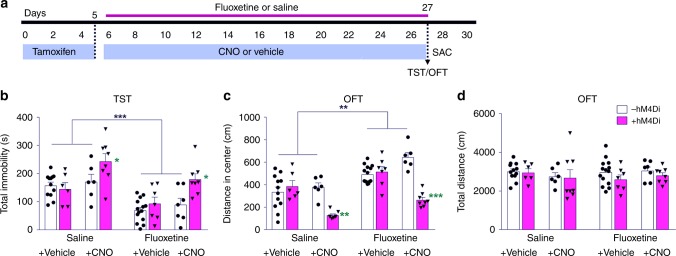Fig. 1.
Silencing newborn dentate gyrus neurons prevents the effects of fluoxetine and alters baseline affective behavior. a Timeline representing the experimental design for determining whether silencing of newborn neurons inhibits the effects of fluoxetine treatment in Ascl1-CreERTM;R26LSL−hM4Di mice. b Total time-spent immobile in tail suspension test, a measure of depression-like behavior (Fluoxetine F1,60 = 23.11, ***P < 0.0001; hM4Di F1,60 = 6.92, *P = 0.011; CNO F1,60 = 15.60, ***P < 0.0001; hM4Di*CNO F1,60 = 5.08, *P = 0.028; Tukey posthoc test + hM4Di + CNO Saline treatment versus other saline treatment groups *P < 0.05; + hM4Di + CNO Fluoxetine treatment versus other fluoxetine treatment groups *P < 0.05). c Distance spent in center exploration in open-field test, a measure of anxiety-like behavior (Fluoxetine F1,60 = 42.32, ***P < 0.0001; hM4Di F1,60 = 28.59, ***P < 0.0001; CNO F1,60 = 5.27, *P = 0.025; hM4Di*CNO F1,60 = 44.46, ***P < 0.0001; Tukey posthoc test + hM4Di + CNO Saline treatment versus other saline treatment groups **P < 0.01; + hM4Di + CNO Fluoxetine treatment versus other fluoxetine treatment groups ***P < 0.0001). d Total distance in open-field test, measure of locomotor activity (Fluoxetine F1,60 = 0.002, P = 0.965; hM4Di F1,60 = 1.297, P = 0.259; CNO F1,60 = 0.138, P = 0.711; hM4Di*CNO F1,60 = 0.030, P = 0.862). Data are presented as means ± s.e.m. and analyzed by three-way ANOVA

